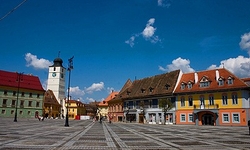
|
LOCATION
ECONOMY CULTURE
The Sibiu area shelters archelogical findings from Late Stone Age, Early Bronze and Iron Age to pre-Roman settlements inhabited by Dacian tribes. Traces of a Roman settlement named Cedonia puts Sibiu on the map of the Dacian Province of the Roman Empire. The colonists, named in the documents “teutonici”, “flandres” or “saxones” established around 1150 a settlement called “Villa Hermanni” – Hermannsdorf, later Hermannstadt, mentioned first in a document in 1191 by Pope Celestin III. Hermannsdorf evolved towards urban life and got the rank of city – civitas in 1366. The craftsmen in Hermannstadt also bartered goods - mainly clothes and tools - with the Romanian population. Production and trade developed and flourished, due to the activity of the guilds. Their first written regulations (1367) mentioned 19 guilds, with 25 trades. Their number constantly grew. The flourishing period was shadowed by the Turkish danger as invasions followed one after the other beginning with 1394, 1432, 1437 and 1438, when the town successfully resisted against a siege led by the sultan Murad th 2nd. The collections were opened to the public in 1817 and became later the core of Brukenthal Museum. In the 18th century the town extended over the precinct walls, forming the district Josephin, Terezian and Lazaret. Since beginning with the 1541 only Saxons could have properties inside the walls of the town, the Romanian population settled in these districts. At the end of World War I, in 1918 the Romanian population decides to unite Transylvania with the Kingdom of Romania, followed in 1919 by the Saxons’ Assembly voted for joining in. Sibiu became the seat of the provisional government until the unification was completed. Sibiu did not suffer distructions during WW II but, after the war, the new communist authorities backed by Moskau began to nationalise the factories and the land while launching waves of pollitical trials and arrests against all oponents. For the population of Sibiu a long suffering began. The communist authorities considered Saxons guilty in corpore for collaborating with the German Reich and many of them were deported in the Soviet Union for forced labour. As economic hardships and oppression grew during the 80’s, the population of Sibiu was fast to rebel against the communist regime in December 1989, when 91 persons lost their life in the armed clashes. During the 90’s the city restored its democratical institutions and faces now the task of renewing the infrastructure and raising the living standard of its inhabitants. Milestones in Sibiu history 1292 - The first hospital in Romania. 1380 - The first documented school in Romania 1494 - The first pharmacy in Romania 1534 - The first papermill in Romania 1544 - The first book in Romanian is printed here. 1551 - The first experiment with rockets in the world by Conrad Hass 1671 - The methane gas is discovered near Sibiu 1782 - Franz Joseph Müller discovers the chemical element Telur 1795 - At Cisnadie is installed the first lightning rod in SE Europe. 1817 - Brukenthal Museum, the first museum in Romania 1852 - First issue of Telegraful Roman the oldest newspaper in SE Europe 1859 - The Liars Bridge, the first cast-iron bridge in Romania 1875 - The first engineering manufacturing in Transylvania 1896 - The first electric power in Romania and the first power line in this part of Europe. 1904 - The second city in Europe where an electric tramway is used 1928 - The first Zoological Garden in Romania 1989 - The second city in Romania rising against the Communists.
|
What I liked the most in the academic program was the directness of the lecturers, the variety of topics and the assessment method, which was a bit different from usual. Most importantly, however, I enjoyed the international ambience of people from China through Turkey to Mexico and of course Europe, and I'm happy I got to get a couple of very good friends whom I surely want to meet again in 2008. Kristof Pius Peto, Corvinus University of Budapest
|
Copyright © 2008, Asociatia Studentilor in Economie si Business - Designed and developed by Anca |


